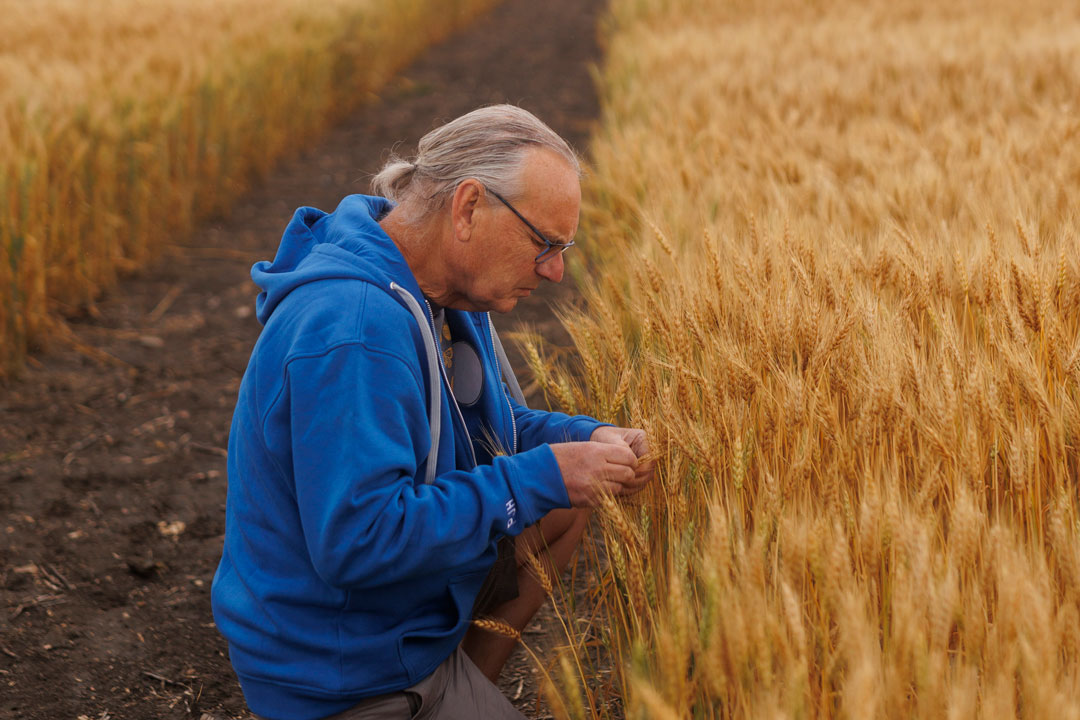
A life in wheat
As Dr. Pierre Hucl (PhD) steps down as a Strategic Research Program (SRP) chair, he reflects on the evolution of wheat breeding in Canada and looks ahead to a bright future.
By Clare Stanfield for AgKnowledgePublic wheat breeding programs, as we know them today, weren’t always a given.
When Dr. Pierre Hucl (PhD) began his career at the University of Saskatchewan (USask) Crop Development Centre (CDC) in 1990, publicly funded breeding programs were more academically focused, somewhat territorial about funding, and not making much of a dent in terms of commercial success.
Today, farmer-directed, publicly funded, collaborative wheat breeding programs are the norm on Canada’s agricultural landscape, and they are regularly producing highly successful varieties like CDC Teal, a juggernaut from years past, and CDC Utmost, a more recent breakthrough for wheat genetics.
“Prior to the creation of the CDC in 1971, crop breeding programs were run by the academic faculty and designed mainly to train grad students and publish papers,” said Hucl, professor in the Department of Plant Sciences and the outgoing chair of Canada Western Red Spring (CWRS), Specialty Wheats and Canaryseed Breeding and Genetics with the Ministry of Agriculture Strategic Research Program (SRP) after 33 years of service.
During that 33-year period, Hucl not only had a front-row seat to the evolution of wheat breeding in Western Canada, but he also had a hand in it.
From little acorns...
While the SRP was only formally established in 2006, it was born of a funding model that had been operating out of the CDC since its inception. Hucl recalls the push to improve and re-focus university-based wheat breeding programs.
“When I started in January of 1990, the program had released three varieties and did not have a substantial market impact,” he said, adding that the focus was mainly on research and graduate student training. In other words, grad students were trained in the science of plant breeding, but resources were not always aimed to support developing new, commercially viable wheat varieties.
After being hired, Hucl set out to transform the CDC’s Spring wheat breeding program.
“At that time, there was a lot of turf protection,” he said of some of the publicly funded institutions around in 1990. “There was huge pressure to not have universities receive farmer-levy check-off funding and I had to be pretty scrappy to get that. Without that funding, we wouldn’t have been able to grow and expand our breeding programs. Without the Western Grains Research Foundation wheat checkoff, there wouldn’t have been wheat breeding at the CDC after 1995-96.”
That program expansion had, and still has, a huge impact on the CWRS wheat landscape.
“At our peak, we had 25 to 30 per cent market share,” said Hucl of CDC-developed wheat varieties.

Reshaping the wheat breeding sector
“The CDC is a unique unit,” said Hucl. “We’re small—only eight scientists—and I think our impact is greater than many other institutions in terms of finding solutions to problems. We’ve been successful because we’ve adopted appropriate technology along the way.
He recalls how, in the early days, the CDC was scoffed at by some funders for adopting the use of molecular genetics in its breeding programs. “We got denigrated for doing that!” he said, laughing. But they stuck to their guns because it was the right technology to address farmers’ needs.
Wheat breeding priorities shifted over the years as the industry evolved. Hucl recalls the demise of the country elevator system in favour of inland terminals. “Right away, this drove a shift toward larger bulk shipments,” he said, adding that with WGRF funding, a concerted effort was made to develop wheat classes other than the dominant CWRS and Amber durum market classes, to meet a diversification need. Unfortunately, these wheat market diversification efforts did not pan out in the long run.
“Regardless, we’ve seen tremendous improvements in grain yield over the last 10 to 15 years alone,” said Hucl. “That change feeds into larger farms and greater efficiencies.”
CWRS wheat breeding was also spurred by the introduction of dwarfing genes that came directly from CIMMYT (the International Maize and Wheat Improvement Centre in Mexico) in the 1960s. But Hucl said the real game-changer for Canadian wheat breeders came in 2007 when the requirement for kernel visual distinguishability (KVD) was dropped as a condition for new variety registration.
“The Americans did away with it in the 1960s,” he said.
It meant that while American breeders could focus on simply improving wheat, Canadian breeders had to kind of reverse engineer genetic material into new varieties in order to get the quality improvements demanded by industry while still meeting KVD requirements. The result was that many potentially great CWRS varieties never made it past the registration testing stage.
“I had a doubled haploid candidate line, so pretty pure, in registration trials,” recalled Hucl. “It passed KVD two years in a row and in the third year 10 per cent of kernels looked like winter wheat and it was turned down.”
By the early 1990s, Hucl said North Dakota State had good wheat varieties close to CWRS quality and when KVD died, that freed Canadian breeders. “Once that germplasm was introduced here, it was a game changer to successful yield improvement of CWRS wheat.”
The next generation
“I’ve been fortunate that I’ve ended up in this role,” said Hucl. “I was just hired to work on wheat, but if you look at the vision statement of CDC—diversification is central.
I started looking at specialty wheats and then canary seed. I’ve always been interested in diversification. I’ve even tried dryland rice and peanuts!”
He has also seen an even more important shift over the years—people choosing agriculture.
“When I started, parents were discouraging their kids from going into agriculture,” said Hucl, adding that from the early- to mid- 1990s the CDC experienced something of a collapse of interest in agriculture as a career. “Our department went from 100 grad students to 40. We’ve managed to rebuild that core of students to about 90 now. In that group, we have a lot of really smart grad students who are good at articulating what they’re doing through social media. It’s a good sign for the future.”
The role of the CDC at USask is also key.
“All the background work that needs to be done is in the public sector—that’s our role: to be the guardian, the backstop of the genetic erosion,” said Hucl. “Once a breeding program is gone, it takes 10 years to rebuild.”
In July this year, Hucl passed his SRP chair baton to Dr. Adam Carter (PhD), assistant professor in the CDC and Hucl’s office neighbour.
“Adam’s office is next to mine so whenever he has a question, he knocks on my door, and we go and look at things together.”
And he has no doubts Carter is the right person for the job.
“He’s very passionate about plant breeding.”
